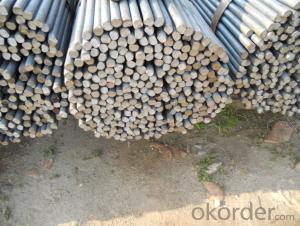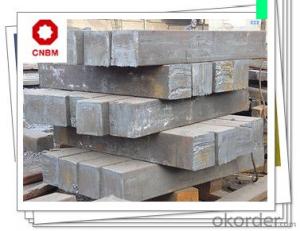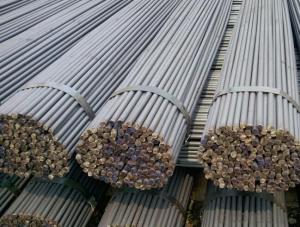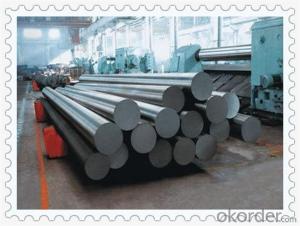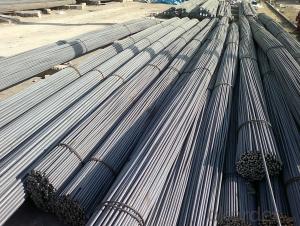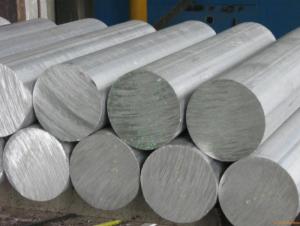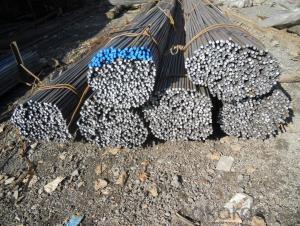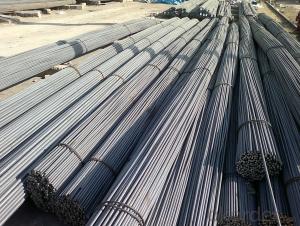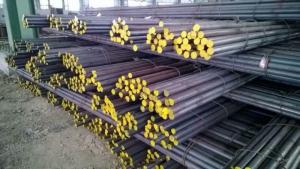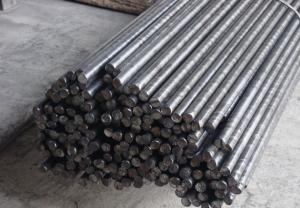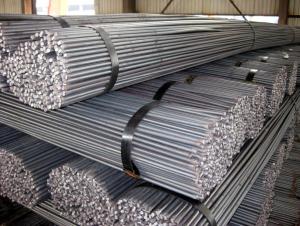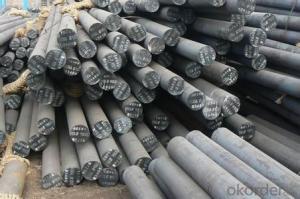low price of round bar hot rolled
- Loading Port:
- China Main Port
- Payment Terms:
- TT OR LC
- Min Order Qty:
- -
- Supply Capability:
- -
OKorder Service Pledge
OKorder Financial Service
You Might Also Like
Specifications
Hot rolled round bar
1)Sizes:10mm-600mm
2)Lengths:4m-9m,other lengths can be customised
3)Standard:GB
Hot rolled steel bar /alloy steel bar
Specification:
OD | Length | Material | Standard | Technique |
16-260mm | 6-12m or aques per request | 20# | GB ASTM DIN | Hot rolled |
16-350mm | 45# | |||
200-500mm | 45# | Forged | ||
20-250mm | 20Cr,40Cr,20-42CrMo | Hot rolled | ||
50-300mm | GCr15 |
Chemical component:
C | Mn | Si | P | S | Cr | Ni | Cu | |
0.18-0.24 | 0.50-0.80 | 0.17-0.37 | ≤0.035 | ≤0.035 | 0.70-1.00 | ≤0.030 | ≤0.030 | |
Application:
30Cr round steel bar is mostly used in carburized parts(oil quenching), such as: transmission gear, gear shaft, CAM, worm, piston pin, claw clutch, etc.
- Q: What are the advantages of using vanadium-alloy steel round bars?
- There are several advantages of using vanadium-alloy steel round bars. Firstly, vanadium increases the strength and toughness of the steel, making it highly durable and resistant to wear and tear. This makes it ideal for applications that require high strength and reliability, such as construction, automotive, and machinery industries. Secondly, vanadium-alloy steel has excellent heat resistance, allowing it to withstand high temperatures without losing its mechanical properties. This makes it suitable for use in environments with elevated temperatures or in applications involving heat treatment processes. Lastly, vanadium-alloy steel offers improved corrosion resistance, reducing the risk of rust and corrosion, and increasing the lifespan of the round bars. Overall, the use of vanadium-alloy steel round bars provides enhanced performance, durability, and reliability, making them a preferred choice in various industrial applications.
- Q: How do you measure the diameter tolerance of a steel round bar?
- To measure the diameter tolerance of a steel round bar, you can follow the steps below: 1. Obtain a caliper or micrometer: These measuring tools are commonly used to measure the diameter of objects accurately. 2. Set the measuring tool: If you are using a caliper, adjust the jaws to the appropriate size range. For a micrometer, ensure it is zeroed correctly. 3. Position the round bar: Place the steel round bar on a flat and stable surface, ensuring that it is not rolling or moving. 4. Take the measurement: Use the measuring tool to capture the diameter of the round bar. For accurate results, make sure the tool is perpendicular to the bar and apply gentle pressure to get an accurate reading. 5. Repeat the measurement: To ensure accuracy, take multiple measurements at different points along the length of the round bar. This will account for any variations or deviations in the bar's diameter. 6. Calculate the average diameter: Add up all the measurements and divide by the number of measurements taken. This will give you the average diameter of the round bar. 7. Compare with the tolerance range: Consult the specifications or standards provided for the steel round bar to determine the allowable tolerance range. This range will indicate the acceptable variation in diameter for the bar. 8. Analyze the results: Compare the average diameter obtained from your measurements with the specified tolerance range. If the average diameter falls within the tolerance range, the round bar meets the required specifications. However, if it falls outside the range, the bar may not meet the required tolerance and might need further inspection or adjustment. By following these steps, you can effectively measure the diameter tolerance of a steel round bar and ensure it meets the necessary specifications for your intended application.
- Q: What is the difference between a hot rolled and a cold drawn steel round bar?
- Hot rolled and cold drawn steel round bars differ primarily in their production methods and resulting characteristics. Hot rolled bars are created by heating a billet or ingot to high temperatures and shaping it through rolling, resulting in a rough, scaled surface with rounded edges. This process allows for quick and efficient production of larger sizes and quantities, however, the steel is less precise in terms of dimensions and has a lower surface finish quality compared to cold drawn steel. In contrast, cold drawn steel round bars are produced by pulling a hot rolled bar through a die at room temperature, resulting in a smooth, polished surface with tighter dimensional tolerances. This process enhances the mechanical properties of the steel, such as improved strength, hardness, and dimensional accuracy. Cold drawing also provides a better surface finish and closer dimensional control compared to hot rolling. Hot rolled steel round bars are often used in construction, manufacturing, and general fabrication due to their lower cost and ease of production. They are suitable for applications where precision and surface finish are not critical factors. On the other hand, cold drawn steel round bars are commonly used in demanding applications that require superior dimensional accuracy, surface finish, and mechanical properties. They are frequently utilized in automotive, aerospace, and machinery industries, where precision and quality are essential. In conclusion, the main disparities between hot rolled and cold drawn steel round bars lie in their production process, resulting surface finish, dimensional accuracy, and mechanical properties. The choice between the two depends on the specific requirements and applications of the steel.
- Q: Can steel round bars be used in the production of musical equipment?
- Yes, steel round bars can be used in the production of musical equipment. Steel is a strong and durable material that is commonly used in the construction of various musical instruments. Steel round bars can be utilized to create structural components such as frames, braces, and supports for instruments like guitars, drums, and pianos. Additionally, steel can be used to manufacture sound-enhancing elements such as resonators or bellows in certain instruments. The versatility and reliability of steel make it a suitable choice for musical equipment production.
- Q: Is there a standard for the grounding of pumping units and the length of the length of the angle steel or round steel?
- Yes, the length of the grounding body must not be less than 2.5 meters.
- Q: How do steel round bars perform under bending or flexing forces?
- Steel round bars generally perform well under bending or flexing forces due to their high tensile strength and ductility. When subjected to bending forces, the steel round bars can resist deformation and maintain their shape, making them suitable for various applications such as construction, manufacturing, and engineering. The combination of high strength and ductility allows the bars to absorb and distribute the applied load evenly, minimizing the risk of failure or breakage. The behavior of steel round bars under bending or flexing forces can be further enhanced by factors such as the alloy composition, heat treatment, and manufacturing process. Different grades of steel can offer varying levels of strength, toughness, and resistance to bending. Heat treatment processes like quenching and tempering can further improve the mechanical properties, making the bars more resistant to bending and flexing. However, it is important to note that excessive bending or flexing can lead to permanent deformation or failure of the steel round bars. Overloading or repeated bending beyond the material's limits can cause stress concentrations, microcracks, or even fractures. Therefore, it is crucial to determine the appropriate bending limits and ensure proper design and installation to maintain the structural integrity and safety of steel round bars under bending or flexing forces.
- Q: What are the different types of steel round bar finishes?
- There are several different types of steel round bar finishes available, each with its own unique properties and benefits. Some common types of steel round bar finishes include: 1. Hot Rolled: This finish is achieved by heating the steel to a high temperature and then rolling it while it is still hot. Hot rolled steel round bars have a rough surface and a blue-grey color. This finish is commonly used for structural applications where aesthetics are not a priority. 2. Cold Rolled: In contrast to hot rolled steel, cold rolled steel round bars are processed at room temperature. This results in a smoother surface and tighter dimensional tolerances. Cold rolled steel round bars are often used in applications that require a more polished look or where precise measurements are essential. 3. Turned and Polished: This finish involves removing the outer layer of the steel round bar through a process called turning. After turning, the bar is polished to achieve a smooth and shiny surface. Turned and polished steel round bars are commonly used in decorative applications or where a high-quality appearance is desired. 4. Ground: Ground steel round bars undergo a grinding process to remove imperfections and achieve a smooth, uniform surface. This finish is often used when tight tolerances and precise measurements are required, such as in machine parts or tools. 5. Chrome Plated: Chrome plating involves applying a layer of chromium onto the surface of the steel round bar. This finish provides enhanced corrosion resistance and a lustrous appearance. Chrome plated steel round bars are frequently used in applications where the material will be exposed to moisture or harsh environments. 6. Galvanized: Galvanizing is the process of coating steel with a layer of zinc to protect it from corrosion. Galvanized steel round bars have a characteristic silver appearance and are commonly used in outdoor applications or environments where rust is a concern. These are just a few examples of the different types of steel round bar finishes available. The choice of finish will depend on the specific requirements of the application, such as aesthetics, corrosion resistance, or dimensional tolerances.
- Q: Can steel round bars be used for making sway bars?
- Yes, steel round bars can be used for making sway bars.
- Q: What are the different types of steel round bar shapes?
- There is a wide range of steel round bar shapes to choose from, each possessing its own distinctive characteristics and uses. Some commonly seen types include: 1. Round: This shape is the most commonly used and versatile for steel round bars. It takes on a cylindrical form and finds application in various industries like construction, manufacturing, and automotive. 2. Square: Square steel round bars feature four equal sides and are often employed when a robust and sturdy form is needed. They are frequently utilized in construction, architectural designs, and machinery. 3. Hexagonal: Hexagonal steel round bars boast six sides, setting them apart with their unique shape. They are often selected for applications requiring high strength and corrosion resistance, such as aerospace, defense, and oil and gas industries. 4. Flat: Flat steel round bars exhibit a rectangular cross-section with flat top and bottom surfaces. They are commonly used when a broad, level surface is desired, as in construction, machinery, and manufacturing sectors. 5. Half Round: Half-round steel round bars adopt a semicircular shape with a flat base. They are frequently employed for handrails, fencing, and decorative purposes. 6. D-shaped: D-shaped steel round bars possess a flat bottom surface and a curved top surface, resembling the letter "D". They are often favored when a sturdy yet lightweight structure is required, such as in automotive frames and chassis. These examples merely scratch the surface of the various steel round bar shapes available. The choice of shape hinges upon the specific requirements of the application, encompassing factors like strength, durability, corrosion resistance, and aesthetic appeal.
- Q: Are steel round bars suitable for architectural applications?
- Yes, steel round bars are suitable for architectural applications. They offer strength, durability, and versatility, allowing them to be used in various architectural designs such as railings, sculptures, and decorative elements. Steel round bars can be easily fabricated and have a sleek and modern aesthetic, making them a popular choice in the architectural industry.
Send your message to us
low price of round bar hot rolled
- Loading Port:
- China Main Port
- Payment Terms:
- TT OR LC
- Min Order Qty:
- -
- Supply Capability:
- -
OKorder Service Pledge
OKorder Financial Service
Similar products
Hot products
Hot Searches
Related keywords



